Ice at the Lunar Poles
By Richard Vondrak, Dana Crider
That the Moon harbors ice at high latitudes is well known. The source of that water, however, may come as something of a surprise
That the Moon harbors ice at high latitudes is well known. The source of that water, however, may come as something of a surprise

DOI: 10.1511/2003.26.322
On March 6, 1998, The New York Times presented its readers with some intriguing news: "An American spacecraft has found evidence that relatively large amounts of frozen water exist on the Moon, scattered in craters over vast spans of the north and south poles...."
This article explained that "[r]ather than being entirely a dry wasteland ... the Moon may have enough water, in the form of small ice crystals mixed in loose dirt, to sustain lunar colonies and provide fuel for rockets exploring the solar system," a reference to the fact that oxygen and hydrogen, the constituents of water, make excellent rocket propellants. Continuing to read on about the Moon, one would have learned that "any water present would have come from its bombardment by comets" and that "the only water that would remain on the airless Moon would have to be hidden in craters in places shielded from sunlight, which would evaporate any moisture."
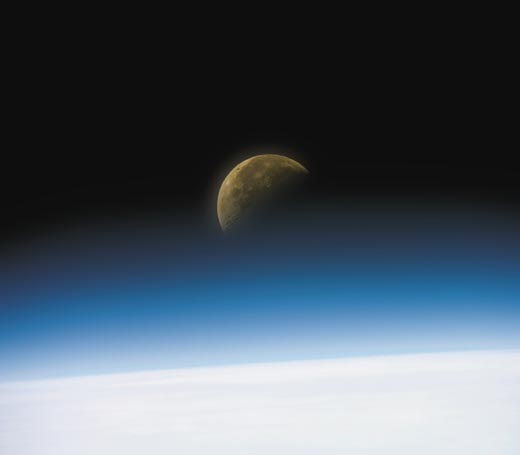
Image courtesy of NASA
This same story, plus or minus some details, appeared that spring in everything from USA Today to NASA press releases. In the five years that have since elapsed, much has been learned from the spacecraft involved in this discovery, and scientists like ourselves have had a chance to ponder and extend these results. So we are in a good position now to review the chain of events leading up to the dramatic 1998 announcement—and to explain why some of the statements made at that time may have to be modified in light of recent scientific progress.
In particular, we would like to describe here why we and others believe that the source of the polar water is more complicated than these news stories indicated. Interestingly, an appreciation for the details of where the water came from also calls into question the assertion that the deposits of ice at the lunar poles represent a unique resource for future colonization or space exploration. A fuller understanding of the origins of this lunar water also highlights what, in our view, may be the greatest value of these ice deposits: as a scientific resource for understanding the evolution of both the Moon and the Earth.
The history of this subject really starts in 1961, when Kenneth Watson, Bruce C. Murray and Harrison Brown of the California Institute of Technology put forth the first serious scientific speculation about the existence of ice at the lunar poles. In an article in the prestigious Journal of Geophysical Research, they pointed out that the equatorial plane of the Moon is canted only 1.5 degrees from the ecliptic (the orbital plane of the Earth and Moon about the Sun). This orientation, which results in the absence of seasons on the Moon, has endured for billions of years. As a consequence, there are places near the poles, such as the interiors of some steep-walled craters, that are permanently shaded from the Sun and thus remain at frigid temperatures—about -200 degrees Celsius—throughout the long lunar day. Any gases that reach such surfaces would quickly freeze in a manner reminiscent of the "cold traps" used in laboratory vacuum systems to collect stray vapors.
The notion that the Moon might harbor ice in its own natural cold traps languished for almost two decades, despite a great deal of scientific scrutiny focused on the Moon during the Apollo space program. Indeed, study of the rocks brought back by the Apollo astronauts showed no evidence that water has ever been present in substantial quantities on the Moon. Yet the concept of cold traps on the Moon re-emerged in 1979, when James R. Arnold of the University of California, San Diego used the information garnered during the Apollo years to estimate that substantial amounts of water might be generated within the lunar soil (which, because it lacks organic components, is more properly called regolith). That water, according to Arnold, may migrate to the lunar poles and be deposited there as ice. But because none of the Apollo landings or orbiters visited the lunar poles, there was really no direct evidence for or against Arnold's supposition.
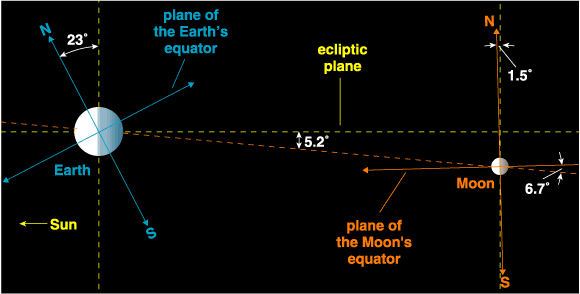
Tom Dunne; Adapted from Spudis 1996
Curiously enough, the next advance came from studies not of the Moon but of the planet Mercury. In the early 1990s maps made with radio telescopes revealed bright radar reflections bouncing back from both polar caps of Mercury. Those reflections had a particular signature consistent with water ice on the surface. Because the spin axis of Mercury is nearly perfectly perpendicular to its orbital plane, that planet too has permanently shaded regions at its poles. So the discovery that such spots hold ice on an otherwise searingly hot planet boosted the credibility of those who predicted that volatiles like water condense and survive in high-latitude cold traps on the Moon.
The first spacecraft to observe the lunar poles in detail was Clementine, a probe that the U.S. Department of Defense and NASA launched in 1994 with the intent of visiting a nearby asteroid. To test its instruments, controllers first sent Clementine into a polar orbit around the Moon. A technical glitch forced the planned asteroidal encounter to be scrubbed, but the scientific payoff from its travels around the Moon was considerable. For example, Clementine discovered a deep gash on the far side of the Moon that extends to the South Pole. That structure, now known as South Pole—Aitken Basin, is an old impact crater, more than 2,500 kilometers in diameter and more than 12 kilometers deep in places (relative to the rim)—that is, deeper than the Marianas Trench in the Pacific Ocean. The existence of this giant basin further revived interest in the possibility of polar ice on the Moon.
Lacking a source of illumination, the optical camera on Clementine could not obtain images from within permanently shaded polar regions. But recognizing the possibility that some of these places might harbor ice, the scientists running the mission attempted an impromptu experiment, one that mimicked the radar technique used earlier to map the ice caps on Mercury. The controllers directed a radio transmitter on Clementine toward the lunar surface in the polar regions and detected the reflected signals on Earth. The Clementine scientists interpreted the results of this test as being consistent with the presence of ice, but others questioned those conclusions. In particular, a group of astronomers using the Arecibo radio telescope were able to detect similar radar reflections from sunlit areas near the lunar poles, suggesting that these signals merely indicated rough topography. So as late as 1997, people still did not know whether or not there is ice at the lunar poles.
At last, in 1998, a probe that offered a way to answer this question visited the Moon. Along with several other instruments, the Lunar Prospector spacecraft carried a neutron spectrometer, which detected a sharp decrease in the flux of medium-energy neutrons emanating from polar regions. This was a key observation, one that merits a full explanation of its significance.

Photograph courtesy of NASA
The surface of the Moon gives off neutrons not because it is itself particularly radioactive. Rather, these neutrons result from the impact of galactic cosmic rays, which rain down from deep space and hit the lunar surface, knocking neutrons out of the regolith. The neutrons that are kicked loose travel quite fast initially, but they then lose their kinetic energy through collisions with the various atoms present until, finally, the neutrons attain the same temperature as the surrounding material. Midway during their transformation from fast to slow (or thermal) neutrons, they are considered "warm" or epithermal neutrons. Remarkably, these physical goings-on (which take place within the top meter or so of lunar regolith) can be monitored from orbit, because some of the neutrons are scattered into space. In particular, one can measure how the flux of epithermal neutrons changes from place to place.
Seeing a relatively large number of epithermal neutrons being given off indicates that the fast neutrons initially formed must be taking their time shedding kinetic energy and becoming thermal neutrons. That is, a lot of neutrons must be lingering at epithermal energies for a long while. Conversely, detecting that only a scant number of epithermal neutrons are cast into space implies that the transformation of neutrons from fast to thermal energy levels is happening quickly. What might account for that? The presence of hydrogen. Why? Because an atom of hydrogen has roughly the same mass as a neutron. So when a neutron collides with a hydrogen atom, the neutron can lose most of its kinetic energy instantly, just as a collision between a speeding cue ball and another billiard ball often leaves the cue ball standing still.
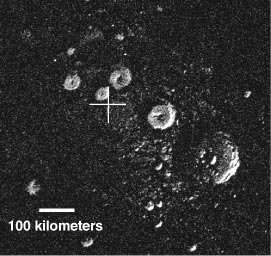
Image from Harmon et al. 2001, courtesy of John Harmon, National Ionosphere and Atmospheric Center Arecibo Observatory, and Academic Press
By measuring the fluxes of neutrons at several energies, mission scientists could use the neutron counters on Lunar Prospector to estimate the amount of hydrogen in the regolith—but only hydrogen, not specifically the hydrogen inside water. The lead investigator working with these instruments, William C. Feldman of Los Alamos National Laboratory, and his coworkers on the Lunar Prospector team found a good bit of hydrogen near the poles, at least some of which they inferred to be in the form of frozen water, in part because the large concentrations found are difficult to explain otherwise. The richest deposits discovered correspond to the floors of polar craters in permanent shadow. This association, too, strongly suggests that ice is present.
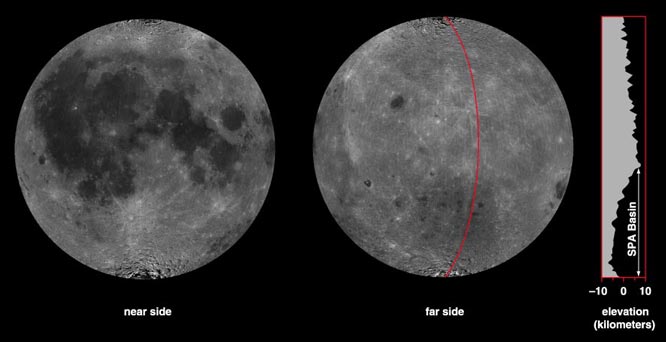
Mosaics courtesy of the U.S. Geological Survey Astrogeology Research Program
Still, the neutron surveys could not show definitively whether the hydrogen detected was in ice. So at the end of its mission, Lunar Prospector was targeted to strike the Moon in an area of a cold trap in the hope that the impact might throw out material that could then be definitively identified.
Lunar Prospector had a mass of just 160 kilograms and was destined to strike the surface at a shallow angle (6.3 degrees), so the crash was expected to vaporize only about 18 kilograms of water. Calculations showed that steam would be emitted for only about 10 seconds. Careful measurements from Earth of the resulting plume, it was thought, might just be able to discriminate between hydrogen bound to minerals and true water products. This plan was controversial because of its expected low probability of success. In particular, some scientists would have preferred slowly reducing altitude to make better measurements until the craft eventually struck a mountain. But in the end, the high-risk experiment was adopted.
On July 31, 1999 Lunar Prospector hit the Moon, presumably where it was aimed: the floor of a permanently shadowed crater near the south pole. But even with the most powerful telescopes, not a puff was seen. Although this negative result proved a disappointment to those of us with a keen interest in the Moon, it came as little surprise: That final experiment was, in more ways than one, a long shot.
Lunar Prospector demonstrated that there is abundant hydrogen at the lunar poles, but the data collected shed very little light on its origins. The hydrogen could come from impacts of icy comets and asteroids. But another possible source, neglected in most accounts, is the protons (hydrogen nuclei) that make up the bulk of the solar wind, the continuous flow of ionized gas emanating from the Sun.
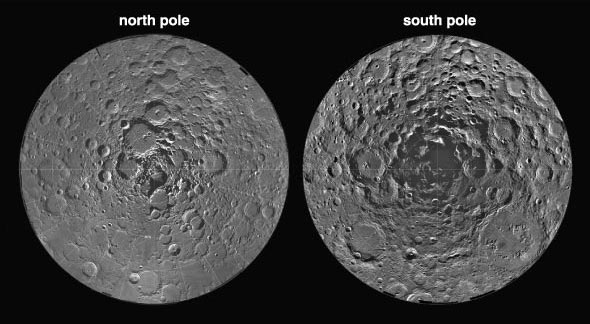
Courtesy of NASA
This ambiguity inspired us to develop a numerical model that, we hoped, might reveal the source of the newly discovered hydrogen. One of us (Vondrak) had worked as a postdoctoral investigator on the Apollo program, analyzing measurements of ions from the thin lunar atmosphere, including the effects of the temporary contamination produced by the gas exhaust of the lunar landers. These studies were very useful in identifying the various processes whereby gases are lost or retained in lunar materials. The other (Crider) had studied the interaction between the solar wind and the upper atmosphere of Mars. With this background, we were eager to examine the ultimate fate of the solar wind that continuously strikes the Moon to see whether this influx might help account for the findings of Lunar Prospector.
Although it is very tenuous, with a density of about five atoms per cubic centimeter, the solar wind flows very fast, about 500 kilometers per second (roughly a million miles per hour), which brings about 40 grams of material to the Moon each second. Over time, this inflow adds up to a considerable supply. When solar-wind protons strike the surface, most immediately pick up electrons and are lost into space as neutral hydrogen or diatomic hydrogen. Some of these solar-wind particles, however, bury themselves in grains of lunar regolith. Later, micrometeorites strike the surface, melting bits of regolith and causing the implanted hydrogen to bond with the oxygen atoms present in various iron oxide minerals. The reaction releases both neutral OH and H2O, and leaves metallic iron embedded in glass. Indeed, iron in glass, the chemical signature of this ongoing process, was seen in rocks that the Apollo missions returned.
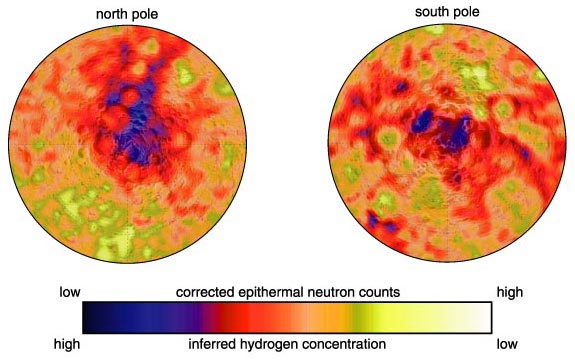
Images courtesy of William C. Feldman
Some of the water molecules created in this way reach the polar cold traps. How do they get there? Once released from the regolith, a particle follows a ballistic trajectory and, because there is essentially no atmosphere, will not collide with anything until it lands. After it sets down, the particle accommodates itself to the local surface temperature and is eventually released again for another hop. Water is too heavy to escape the weak lunar gravity, but atomic and diatomic hydrogen are not. The way most of the water is lost before reaching the poles is through photodisassociation—sunlight breaks them apart. In the end, a tiny fraction, about 0.04 percent of the solar-wind protons that hit the Moon in the first place, arrives at the cold traps in the form of water vapor, which presumably freezes out.
We reached this conclusion with the help of a computer model that simulates the random migration of water molecules from lower latitudes to the polar regions. Our model shows that although the process is inefficient, it can nevertheless deliver large amounts of water to the lunar poles, about four tons per year. If the resulting deposits were durable, they would be able to build up to the quantity that Lunar Prospector indicated in only 100 million years, which, considering that the surface of the Moon has remained largely unchanged over the past few billion years, represents a comparatively short span.
In addition to the steady supply from solar-wind hydrogen and oxygen-bearing minerals, the episodic impact of comets presumably provides an additional source of water, which could conceivably be of considerable importance. For example, completely covering all the cold traps with an ice layer 10 centimeters thick would require about 1015 grams of water, which could be carried in a comet with a diameter of only 1 kilometer and a water content of 10 percent. Of course, when such a body blasts into the Moon, things get quite hot, and much of the water present would be immediately lost to space. We have not yet modeled this complex process, so we cannot predict the consequences. Still, one can surmise that the residual gases released might form a temporary atmosphere around the Moon, which would then deliver some of this water vapor to the polar cold traps.
Whether the water comes from solar wind or from comets or from a combination of these two routes remains a matter of some speculation. But what is clear is that the Moon has ample sources of water and ways for it to reach the poles. How long would the ice formed in cold traps survive? Although no rain falls on it, no rivers flow through it and no glaciers advance over it (actions that quickly erode the land here on Earth), the lunar surface is exposed to various subtle assaults that slowly alter its makeup. And the ice in cold traps is in no way immune from such "space weathering."
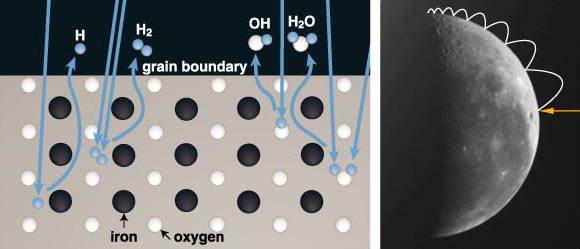
Barbara Aulicino
One might guess that the ice would slowly disappear in any case, through sublimation (transformation from solid directly to gas). In fact, at the frigid temperatures of the lunar cold traps, sublimation would take billions of years. One could also imagine that some of the ice would erode away because photons coming from distant stars hit it from time to time, as do protons coming from the Sun. But these processes do not prove very effective, and they become totally irrelevant if the ice is covered with even a thin layer of dust. The main agents that weather ice deposits, it turns out, are meteorites.
The impact of a meteorite produces a crater, but it also blankets a much wider area with ejecta, the stuff kicked up in the collision. Thus a meteorite fall either adds or removes material, depending on position with respect to the impact point. To study how a continual barrage of meteorites affects these ice deposits, we formulated another numerical model. For this one, we assumed a flat surface, in which the area of the ejecta blanket laid down after a meteorite impact is about four times the area of the crater that is created. So a typical point on the surface will experience more burials than excavations, thereby increasing its elevation with time. The net effect is a process called "gardening," because it is reminiscent of the purposeful overturning of soil.
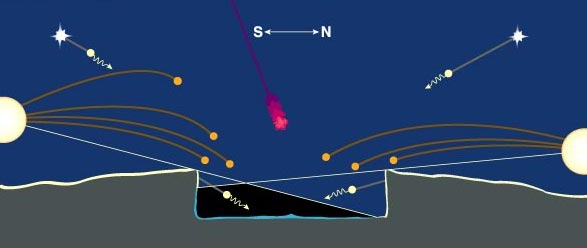
Tom Dunne
Incoming meteorites with mass greater than one milligram are so infrequent on the Moon that we could treat them as individual events in our simulation. Smaller bodies are, however, so numerous that we had to consider their arrivals as a continuous process. Our model demonstrates that the bombardment from meteorites and other loss mechanisms removes most of the ice derived continuously from the solar wind, leaving only about 6 percent of the original amount. Our modeling of these space-weather processes also shows that the water freezing out continuously on the surface gets spread rather uniformly through the upper meter or two of the lunar regolith in about a billion years. Interestingly, we found that over longer periods the ice does not get any more concentrated—it merely reaches to greater depths.
A more complex pattern emerges when we allow that larger meteorites also arrive from time to time. A nearby strike would, typically, dump ejecta on the surface of a cold trap, burying the site under a layer of material that contains very little hydrogen. (Even if the meteorite scooped up material rich in ice, the heat of impact would cause most of it to evaporate.) Such an ejecta blanket slowly accumulates ice at the top, a result of the continuous generation and transport of water from the solar wind. The ongoing gardening mixes some of that ice downward. So given enough time, a thin ejecta blanket, which was initially depleted of hydrogen, could regain the same concentration as in the regolith below. Alternatively, this stratum might become so thick initially or so quickly buried by other layers of ejecta that it gets preserved in something like its original state.

Dave Schneider
The pattern of ice concentration as a function of depth that one would find at a particular spot would thus depend on the history of nearby impacts and whether these events excavated material or deposited it at the site in question. But our numerical model, which we put through some 100,000 randomly arranged runs, allowed us to calculate the overall outcome. We found that on average only about 6 percent of the ice originally delivered to the cold traps remains. Still, this leaves them with about 4 percent water by weight.
Our estimate for the amount of water retained within a cold trap is close to the amount that Feldman and his colleagues estimate to be present on the basis of their neutron surveys (around 1.5 percent ice by weight). Given the uncertainties—both in our modeling and in the Lunar Prospector measurements—our results indicate the solar wind is an ample source for the hydrogen detected in the polar cold traps. And our computer model suggests that there is more hydrogen at depths greater than one meter, something Lunar Prospector could not sense.
But what of the many comets that have hit the moon; surely they delivered some water to the cold traps too, did they not? Perhaps. But we suspect that their additional contribution is minor. After all, when a comet suddenly deposits a layer of ice on the surface of a cold trap, gardening will prevent most of it from being preserved. What is more, gardening will slowly mix what remains into the underlying regolith. With our model, we find that even an ice layer deposited suddenly must be about 10 centimeters thick to be noticeable over the background of ice that accumulates gradually from the action of the solar wind. For thinner strata, the comet-borne ice just gets mixed in with what was delivered continuously. That is not to say that some subtle chemical or isotopic signature of the original ice layer would not remain, but we suspect that it would take a careful analysis to uncover it.
Some people speculate that the ice at the lunar poles might one day supply water for a lunar base or be used as a rocket fuel, thus enabling easier exploration of the solar system. Although these deposits might be tapped for such ends, one should remember that a great deal of hydrogen and oxygen is available at lower lunar latitudes too, where it would probably be more accessible to lunar colonists than at the poles. For example, the concentration of hydrogen in the regolith at the Apollo landing sites is roughly 50 parts per million. It could be released by simply heating these materials. Oxygen, too, is plentiful. Indeed, typical Moon rocks contain almost 50 percent oxygen by weight within various oxide minerals. As many workers have shown, some of this oxygen could be readily extracted by heating lunar regolith in the presence of hydrogen. So it is unclear whether future lunar colonists would need to mine polar ice deposits to get their water and rocket fuel. But these deposits will have a unique scientific value, whether or not they ever offer any commercial payoff as an exploitable resource.
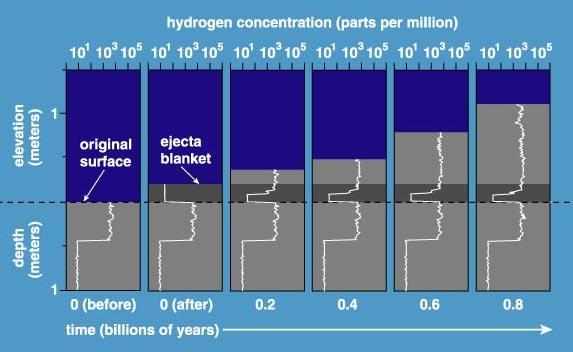
Dave Schneider
Cores retrieved from lunar cold traps might provide a frozen record of the past, analogous to the ice cores retrieved from Greenland and Antarctica, which chronicle the history of the Earth's climate over hundreds of thousands of years with ice that is thousands of feet thick. On Earth, seasonal changes in snowfall often leave bands of varying thickness and composition in ice cores, which reveal annual variation in temperature and precipitation that took place during the distant past. The lunar record would be considerably more compact—each millimeter corresponding to perhaps a million years of time. But if scientists prove able to decode the information contained in lunar polar ice cores, we could learn something about the ancient changes in the solar wind and perhaps even about dramatic events in the Earth-Moon system, such as cometary and asteroidal impacts, which may have left traces in the lunar ices.
For example, the ratio of deuterium (a heavy isotope of hydrogen) to normal hydrogen varies between the Sun, comets and the interstellar medium. Records of this ratio in lunar ices may establish whether there have been times when the solar wind changed in composition or when large comets struck the Earth-Moon system. Such measurements might also show whether dense clouds of interstellar gas ever penetrated into the inner solar system.

Dave Schneider
Interpreting such lunar cores will probably be difficult, given that the effects of gardening and sporadic meteorite impacts may produce signals that are muted, inconsistent from place to place and otherwise confusing. However, if planetary scientists are able to sort all this out, the results might provide scientific insights into the past that cannot be obtained in any other way.
Obviously, the next step is to measure more precisely the polar regions of the Moon and eventually to sample them. Soon the European Space Agency will place into lunar orbit SMART-1, the first Small Mission for Advanced Research and Technology. Although the SMART-1 sensors are not specifically designed for detecting polar ice, they will search for the infrared signature of ice in the permanently shadowed craters.
Japan, too, will soon launch a probe destined for the Moon: the Lunar-A mission, which will carry two penetrators. These devices, targeted to strike the Moon at mid-latitudes on both the near side and far side, will measure the flow of heat from the lunar interior to the surface, heat flow being an important parameter in the calculation of the temperature in the polar cold traps. In 2005 Japan plans to fly a highly capable remote-sensing mission, known as SELENE (short for SELenological and ENgineering Explorer).
U.S. scientists have conceived of various missions targeted specifically at studying ice deposits at the lunar poles, but NASA has not yet allocated funds for any of them. A team led by Paul Lucey of the University of Hawaii recently proposed a particularly ambitious mission called Polar Night, which consists of a remote-sensing orbiter and several instrumented probes that can penetrate the lunar surface. The landing sites for the penetrators will be selected from the orbital mapping of the temperature, hydrogen abundance and radar signature of the candidate polar regions. After six months of mapping, the probes will be targeted to land in the cold traps where they will measure directly the hydrogen and water content. If selected by NASA next year, Polar Night could be launched in 2007.
Whether or not Polar Night is funded, it is a sure bet that, eventually, some new mission will visit the polar cold traps in an effort to answer the many outstanding questions. So we are optimistic that one day soon investigators will know for certain how much water exists at the lunar poles, what form it takes and whether it comes from comets or, as we believe, primarily from the action of the solar wind. And one can begin now to envision how planetary scientists will analyze lunar ice cores to decode the past few billion years of history of the Earth-Moon system, just as glaciologists today study ice cores to elucidate more recent events in our planet's past.
Click "American Scientist" to access home page
American Scientist Comments and Discussion
To discuss our articles or comment on them, please share them and tag American Scientist on social media platforms. Here are links to our profiles on Twitter, Facebook, and LinkedIn.
If we re-share your post, we will moderate comments/discussion following our comments policy.